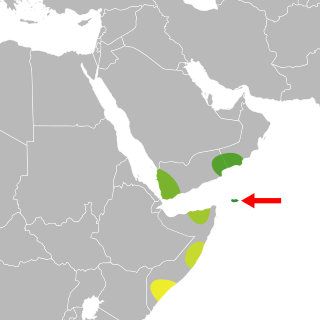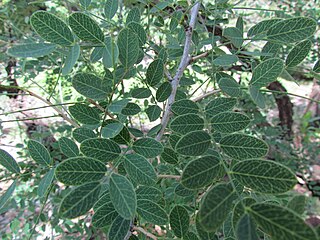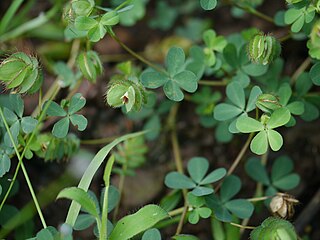
Weberbauerella is a South American genus of flowering plants in the legume family, Fabaceae. It includes three species of perennial herbs or subshrubs native to coastal Peru and northern Chile. They grow in seasonally-dry tropical coastal forest, on sand or sandy hills. It was recently assigned to the informal monophyletic Dalbergia clade of the Dalbergieae.

Geoffroea is a rather small genus of wild spiny shrubs or small trees of tropical and subtropical South America. Although it gathers few species, they are highly extended geographically throughout the subcontinent. Each species is well known in its local area, as seen from the varied usage of these trees as food, timber, or fuel. It was recently assigned to the informal monophyletic Pterocarpus clade within the Dalbergieae.

Chapmannia is a genus of flowering plants in the family Fabaceae. It contains seven species with a scattered distribution – Mexico, Guatemala, Florida, and Venezuela in the Americas, and Somalia and Socotra in eastern Africa. The genus was recently assigned to the informal monophyletic Pterocarpus clade of the Dalbergieae.

Paramachaerium is a genus of flowering plants in the family Fabaceae native to Amazonia. It was recently assigned to the informal monophyletic Pterocarpus clade within the Dalbergieae.

Zygocarpum is a genus of flowering plants in the legume family, Fabaceae. It includes six species of shrubs and small trees native to Somalia and Socotra, and to Yemen and Oman on the southwestern Arabian Peninsula. Three species are endemic to Somalia, two to the Arabian Peninsula, and one to Socotra. Typical habitats include seasonally-dry tropical woodland, thicket, and bushland, often on limestone and less often on granite-derived or sandy soils, up to 2000 meters elevation.

Brya is a genus of flowering plants in the legume family, Fabaceae. It includes seven species of shrubs or small spreading trees native to Cuba and Hispaniola in the Caribbean. It belongs to the subfamily Faboideae, and was recently assigned to the informal monophyletic Pterocarpus clade of the Dalbergieae. Species include Brya ebenus, a valuable timber tree.
Cascaronia astragalina is a species of flowering plant in the legume family, Fabaceae. It is the only member of the genus Cascaronia. It is a spindly shrub or multi-stemmed tree native to southern Bolivia and northwestern Argentina. It grows in seasonally-dry subtropical forests, at forest margins and along rivers.

Cranocarpus is a genus of flowering plants in the legume family, Fabaceae. It includes three species native to northern and eastern Brazil. It belongs to subfamily Faboideae, and was recently assigned to the informal monophyletic Pterocarpus clade of the Dalbergieae.
Cyclocarpa stellaris is a species of flowering plant in the legume family, Fabaceae. It is an annual or perennial herb or subshrub. It has a disjunct distribution, from Senegal to Tanzania and Mozambique in sub-Saharan Africa, in Indochina, Peninsular Malaysia, Borneo, and Java, and in western and northern Australia. It is the only member of the genus Cyclocarpa.

Diphysa is a genus of flowering plants in the legume family, Fabaceae. It belongs to the subfamily Faboideae, and was recently assigned to the informal monophyletic Dalbergia clade of the Dalbergieae. It includes 22 species which range from Arizona through Mexico and Central America to Colombia and Venezuela.
Discolobium is a genus of flowering plants in the legume family, Fabaceae. It belongs to the subfamily Faboideae, and was recently assigned to the informal monophyletic Pterocarpus clade of the Dalbergieae. It includes seven species native to South America, ranging from northern Brazil to Bolivia and northern Argentina.
Fiebrigiella gracilis is a species of flowering plants in the legume family, Fabaceae. It is the only member of the genus Fiebrigiella. It belongs to the subfamily Faboideae, and was recently assigned to the informal monophyletic Pterocarpus clade of the Dalbergieae. It is a subshrub native to Ecuador, Peru, and Bolivia.
Fissicalyx fendleri is a species of flowering plant in the legume family, Fabaceae. It is a tree native to the tropical Americas, ranging from Panama through Colombia, Venezuela, and Guyana to northern Brazil. It grows in humid lowland forest.

Geissaspis is a genus of flowering plants in the family Fabaceae. It contains one accepted species, Geissaspis cristata. It is a scrambling annual or perennial that ranges from the Indian Subcontinent through Indochina to southern China and Peninsular Malaysia. It has three varieties:

Inocarpus is a small genus of flowering plants belonging to the subfamily Faboideae of the legume family, Fabaceae, and was recently assigned to the informal monophyletic Pterocarpus clade within the Dalbergieae.

Platypodium is a genus of flowering plants in the family Fabaceae. It includes two species of trees native to the tropical Americas, from Panama through Colombia, Venezuela, and Brazil to Bolivia and Paraguay. Typical habitats are seasonally-dry tropical forest, humid gallery or riverine forest, thicket, and woodland. It belongs to the subfamily Faboideae, and has been assigned to the informal monophyletic Pterocarpus clade within the Dalbergieae.
Riedeliella is a genus of flowering plants in the legume family, Fabaceae. It includes three species of scandent shrubs native to Paraguay and eastern and west-central Brazil. They grow in seasonally-dry tropical forest, cerrado, and caatinga. The genus belongs to the subfamily Faboideae, and was recently assigned to the informal monophyletic Pterocarpus clade within the Dalbergieae.
Soemmeringia semperflorens is a species of flowering plants in the legume family, Fabaceae. It is the only member of the genus Soemmeringia.

The tribe Dalbergieae is an early-branching clade within the flowering plant subfamily Faboideae. Within that subfamily, it belongs to an unranked clade called the dalbergioids. It was recently revised to include many genera formerly placed in tribes Adesmieae and Aeschynomeneae and to be included in a monophyletic group informally known as the dalbergioids sensu lato. The members of this tribe have a distinctive root nodule morphology, often referred to as an "aeschynomenoid" or "dalbergioid" nodule.
Steinbachiella leptoclada is recently reinstated species of flowering plant in the legume family, Fabaceae. It is a tree endemic to Bolivia. It is the only member of the monotypic genus Steinbachiella. The genus is assigned to the informal monophyletic Dalbergia clade of the Dalbergieae.











